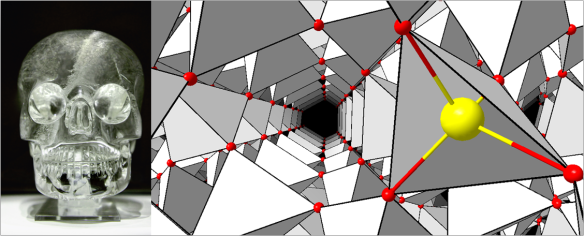Posted on 14/01/2014
Quartz: Dear Indi – Let me in next time!!!
What does it look like?

Left, Crystal skull from the British Museum – picture taken by Rafał Chałgasiewicz. Right, the crystal structure of quartz - representation was generated using the program Diamond. http://www.crystalimpact.com/diamond/
What it is ?
Quartz is the second most abundant mineral in the Earth's continental crust, after feldspar. Basically, it is a finite infinite framework of SiO4 Silicon-Oxygen tetrahedra (Silicon is displayed in yellow, Oxygen in red), with each oxygen at the corner of two tetrahedra. Its chemical formula is SiO2 and its symmetry is trigonal and unit cell can be described with two dimensions a = 4.9133 Å, c = 5.4053 Å.
You may have heard about the Mayan crystal skulls, also named "The skull of Doom" or just watched "Indiana Jones and the Kingdom of the crystal skull". Well, the "Mitchell-Hedges" crystal skull made from a single clear quartz crystal remains one of the most famous and enigmatic mysteries of history. Why was it made? Perhaps such things are beyond science!
Back to quartz itself… The pure quartz, also named "rock crystal", is colourless and clear/transparent but can be found in a number of difference colours such as yellow for the citrine, rose for the rose quartz, bright to dark purple for the amethyst, grey and translucent for the smoky quartz or white for the milky quartz. These are several different varieties of quartz, which differ in their microstructure, but we today we’ll keep to pure clear quartz.
Quartz has been used for many years because of its piezoelectric properties, small amounts of electricity are generated when you pressurise (or squeeze) quartz. This was discovered in 1880 by Jacques and Pierre Curie. Quartz crystal oscillators were thus patented in 1923 then, when it was realised that this invention could be used to keep time, 1927 saw the first quartz oscillator clock.
Where did the structure come from?
This structure of Quartz came from a paper published by Zachariasen and Plettinger (Acta Cryst. 1965).


